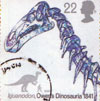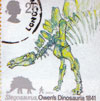Dinosaurs and dragons: stamping on the legends
by Russell Grigg
     |
Dinosaurs are loose in Britain! They come in the form of five postage stamps depicting an Iguanodon, a Stegosaurus, a Tyrannosaurus, a Protoceratops and a Triceratops.1 The stamps were released by the Royal Mail on August 20, 1991, to celebrate the 150th anniversary of the first use of the term ‘dinosauria’ (from the Greek deinos ‘terrible’ + sauros ‘lizard’) by famous British anatomist and palaeontologist, Sir Richard Owen. He used the term at a meeting of the British Association for the Advancement of Science, held in Plymouth, in 1841.
Sir Richard Owen was Britain’s foremost expert in comparative anatomy and was the first person to realize that these creatures were a distinctive group of previously unknown reptiles. While everyone now accepts this conclusion, it is less well known today that Owen opposed Charles Darwin and the theory of evolution on scientific grounds.2
Since their discovery, dinosaurs have been depicted on at least 280 stamps, representing 70 sets from some 50 countries, including such diverse places as Russia, Morocco, Yemen, Nicaragua, China, Mongolia, Laos, Vietnam, Cuba and British Antarctic Territory. Surprisingly, the non-existent Brontosaurus is depicted and named on two stamps—a USA 25¢, showing a pair of the animals, and a Central African Republic SOF, showing a herd.3 There have been more stamp issues depicting Tyrannosaurus than the total number of fossils of this dinosaur found—only three complete skeletons to date.4 Evolutionists believe that the dinosaurs evolved, while creationists believe that they were some of the ‘beasts of the earth’ created by God, along with the other land-dwelling animals on Day Six of Creation Week (Genesis 1:24–31).5 Who is right?
Evolutionist Expectation
If evolution is true, we should expect that:
- There would be fossil evidence indicating the ancestor of all the
 dinosaurs.
dinosaurs. - There would be fossil evidence of intermediate forms showing many stages in the formation of such diverse characteristics as the plates and spikes of the armoured dinosaurs (stegosaurs), the one-to-seven horns of the horned dinosaurs (ceratopian), the distinctive beaks of the duckbilled dinosaurs (hadrosaurs), the thick skulls of the boneheaded dinosaurs (pachycephalosaurs), and also the wings of the flying reptiles (pterosaurs), the distinctive features of the various marine reptiles, and so on.
In fact, all dinosaurs appear fully formed in the fossil record, without trace of an ancestor, and there is not one single dinosaur fossil that can be called an intermediate form between any of the types known.
Creationist Expectations
On the other hand, if creation is true, and the dinosaurs were created on
Day Six of Creation Week, we should expect that:
- Dinosaur fossils would appear suddenly in the fossil record, that is, without ancestors and intermediate forms. In fact, this is what is observed.
- If dinosaurs were created by God on Day Six of creation Week, it follows that two of every kind still living at the time of the Flood must have gone aboard Noah’s Ark. Could such large animals have been accommodated?
Aboard Noah’s Ark

First of all, they were not all large; many dinosaurs were comparatively small, such as Compsognathus, which was about the size of a chicken, and Mussaurus, the smallest dinosaur ever found, the skull of which measured a mere 32 millimetres in length6—about the length of an ordinary paper-clip. Second, the dinosaurs, like modern reptiles, usually laid eggs which had a leathery shell (compared to birds’ eggs which have a hard shell); reptiles today, after hatching, keep growing for most of their lives.
The largest dinosaur egg found was discovered in France; it is 30 centimetres (one foot) long and is now on display at Reading University in England. Others from the same site are 25 centimetres in length or about the size of a football; they were laid by a giant sauropod, which was a gigantic quadrupedal (four-legged) herbivore (plant-eater). The reason for this comparatively small size is that the larger the egg, the thicker the shell has to be and, if it had been too thick, neither enough air could have passed through it to supply the baby dinosaur inside, nor could the baby dinosaur have succeeded in breaking out.7
So, if baby dinosaurs are football size, it is reasonable to suppose that God would have directed children-sized dinosaurs of the larger species to the Ark, or perhaps teenage-sized ones; it certainly was not necessary for Him to have sent grandfather-sized ones!
 The third thing that we might reasonably expect, if God created the dinosaurs on Day Six of Creation Week, is that there should be stories of dinosaurs in the folklore of many nations, since people after the Flood would have co-existed with them until they became extinct. Such stories would not use the term ‘dinosaur’, of course, because as we have already noted, this term was not invented until 1841. We should expect such stories to use other terms like ‘monster’ or ‘dragon’.Dragon storiesIn fact, there are many such stories, from all over the world. One of the oldest is of Gilgamesh, hero of an ancient Babylonian epic, who killed a huge reptile-like creature named Khumbaba, in a cedar forest.8 The early Britons provide the first European accounts of reptilian monsters, one of which killed and devoured King Morvidus of Wales, c. 336 BC. Another monarch, King Peredur, however, managed to slay his monster at a place called Llyn Llion, in Wales.9,10One of the oldest is of Gilgamesh, hero of an ancient Babylonian epic, who killed a huge reptile-like creature named Khumbaba, in a cedar forest.The epic Anglo-Saxon poem Beowulf tells how Beowulf (c. AD 495–583) of Scandinavia killed a monster named Grendel, and its supposed mother, as well as several sea-reptiles,11 but eventually lost his life at the age of 88 in the process of killing a flying reptile. The Saxon description of this creature fits that of a giant Pteranodon—it was ‘fifty feet in length (or possibly wingspan)’.12 The monster called Grendel, which Beowulf killed many years previously, is described as follows. He was apparently a youngster (having been known for only 12 years), man-like in stance (i.e. bipedal), and he had two small forelimbs that the Saxons call eorms (arms), one of which Beowulf tore off. He was a muthbona—one who slew with his mouth or jaws—and his skin was impervious to swordblows.13Other well-known stories involving medieval heroes and dragons include Siegfried of the ancient Teutons (possibly the same person as Sigurd of Old Norse, who slew a monster named Fafnir),14 Tristan (or Tristram), King Arthur, and Sir Lancelot, of Britain,15 and perhaps the most famous of all, St George who became the patron saint of England. (The film and video The Great Dinosaur Mystery16 details many more of these accounts besides those listed here.)The dragon ensign was used by many armies. Under the later eastern Roman emperors, the purple-dragon ensign became the ceremonial standard, called the drakonteion.17 In England, before the Norman Conquest in 1066, the dragon was chief among the royal ensigns in war, having been instituted by Uther Pendragon, father of King Arthur. Other kings who used the dragon ensign were Richard I, in 1191, when on crusade, and Henry III, in 1245, when he went to war against the Welsh.18In China, the dragon appears as the national symbol and the badge of the royal family, and the dragon adorned the Chinese flag until the founding of the Republic of China, in 1911.Although doubtless over the years many of these dragon stories and drawings have gained embellishments, the fact of their virtual worldwide existence, and the many items of similarity between the creatures slain and known dinosaur fossils, clearly point to an underlying reality. Modern children’s story books about dragons invariably have drawings of fairy-tale creatures, but according to Paul Taylor,19 who has done extensive research on this issue, many (perhaps most) of the historical dragon stories do not have this imaginative element; usually the more ancient stories are more matter-of-fact in quality, while the more recent ones tend to be more fantastic. One explanation of this could be that as the evidence in the form of the dinosaurs became extinct, the storytellers felt free to make their stories more marvellous and to combine the features of several dragons into one.
The third thing that we might reasonably expect, if God created the dinosaurs on Day Six of Creation Week, is that there should be stories of dinosaurs in the folklore of many nations, since people after the Flood would have co-existed with them until they became extinct. Such stories would not use the term ‘dinosaur’, of course, because as we have already noted, this term was not invented until 1841. We should expect such stories to use other terms like ‘monster’ or ‘dragon’.Dragon storiesIn fact, there are many such stories, from all over the world. One of the oldest is of Gilgamesh, hero of an ancient Babylonian epic, who killed a huge reptile-like creature named Khumbaba, in a cedar forest.8 The early Britons provide the first European accounts of reptilian monsters, one of which killed and devoured King Morvidus of Wales, c. 336 BC. Another monarch, King Peredur, however, managed to slay his monster at a place called Llyn Llion, in Wales.9,10One of the oldest is of Gilgamesh, hero of an ancient Babylonian epic, who killed a huge reptile-like creature named Khumbaba, in a cedar forest.The epic Anglo-Saxon poem Beowulf tells how Beowulf (c. AD 495–583) of Scandinavia killed a monster named Grendel, and its supposed mother, as well as several sea-reptiles,11 but eventually lost his life at the age of 88 in the process of killing a flying reptile. The Saxon description of this creature fits that of a giant Pteranodon—it was ‘fifty feet in length (or possibly wingspan)’.12 The monster called Grendel, which Beowulf killed many years previously, is described as follows. He was apparently a youngster (having been known for only 12 years), man-like in stance (i.e. bipedal), and he had two small forelimbs that the Saxons call eorms (arms), one of which Beowulf tore off. He was a muthbona—one who slew with his mouth or jaws—and his skin was impervious to swordblows.13Other well-known stories involving medieval heroes and dragons include Siegfried of the ancient Teutons (possibly the same person as Sigurd of Old Norse, who slew a monster named Fafnir),14 Tristan (or Tristram), King Arthur, and Sir Lancelot, of Britain,15 and perhaps the most famous of all, St George who became the patron saint of England. (The film and video The Great Dinosaur Mystery16 details many more of these accounts besides those listed here.)The dragon ensign was used by many armies. Under the later eastern Roman emperors, the purple-dragon ensign became the ceremonial standard, called the drakonteion.17 In England, before the Norman Conquest in 1066, the dragon was chief among the royal ensigns in war, having been instituted by Uther Pendragon, father of King Arthur. Other kings who used the dragon ensign were Richard I, in 1191, when on crusade, and Henry III, in 1245, when he went to war against the Welsh.18In China, the dragon appears as the national symbol and the badge of the royal family, and the dragon adorned the Chinese flag until the founding of the Republic of China, in 1911.Although doubtless over the years many of these dragon stories and drawings have gained embellishments, the fact of their virtual worldwide existence, and the many items of similarity between the creatures slain and known dinosaur fossils, clearly point to an underlying reality. Modern children’s story books about dragons invariably have drawings of fairy-tale creatures, but according to Paul Taylor,19 who has done extensive research on this issue, many (perhaps most) of the historical dragon stories do not have this imaginative element; usually the more ancient stories are more matter-of-fact in quality, while the more recent ones tend to be more fantastic. One explanation of this could be that as the evidence in the form of the dinosaurs became extinct, the storytellers felt free to make their stories more marvellous and to combine the features of several dragons into one.- The fourth thing that we might reasonably expect, if God created the dinosaurs on Day Six of Creation Week, is that they would be mentioned elsewhere in the Bible.
Dinosaurs in the Bible
As the evidence in the form of the dinosaurs became extinct, the storytellers felt free to make their stories more marvellous and to combine the features of several dragons into one.
In fact, two such animals are described in the book of Job. The first is a giant vegetarian animal that may be either a Diplodocus or a Brachiosaurus: ‘Behold now behemoth which I made with thee; he eateth grass like an ox …. He moveth his tail like a cedar … his bones are like bars of iron, he drinketh up a river’ (Job 40:15–24).
 The second appears to have been some sort of large fire-breathing animal. Just as the small bombardier beetle has an explosion-producing mechanism, so the great sea-dragon may have had an explosion-producing mechanism to enable it to be a real fire breathing dragon: ‘Canst thou draw out leviathan with a hook … his breath kindleth coals and a flame goeth out of his mouth ….’ (Job 41:1–34).
The second appears to have been some sort of large fire-breathing animal. Just as the small bombardier beetle has an explosion-producing mechanism, so the great sea-dragon may have had an explosion-producing mechanism to enable it to be a real fire breathing dragon: ‘Canst thou draw out leviathan with a hook … his breath kindleth coals and a flame goeth out of his mouth ….’ (Job 41:1–34).
It is also interesting that in the King James version of the Bible the term ‘dragon(s)’ is used more than 20 times in the Old Testament,20 once metaphorically, referring to the Pharaoh King of Egypt as a dragon (Ezekiel 29:3), and the other times referring to animals; for example, ‘… the young lion and the dragon shalt thou trample under foot’ (Psalm 91:13), ‘And I will make Jerusalem heaps and a den of dragons …’ (Jeremiah 9:11).
This has special significance when it is realized that the KJV was published in the year AD 1611; that is to say, less then four centuries ago, the translators of the Bible were happy to use the term ‘dragon’, confident that its use would be meaningful and not mythical for the readers.
Conclusion
All the predictions and expectations, with respect to dinosaurs, arising from the creation model, are seen to be fulfilled, while none of the predictions and expectations arising from the evolution model are. It is therefore reasonable to conclude that if evolutionists were not locked into their millions-of-years scenario, there would be no problems about the idea that dinosaurs and man have coexisted on the earth, from the time of Adam, until they, along with many other creatures, gradually became extinct.
Related Articles
Further Reading
References and notes
- The Iguanodon is the only one of the five dinosaurs that has been found in Britain and was the first such fossil found, in 1822, by Dr. Gideon Mantrell and his wife Mary Ann; the others have all been found in North America. Return to text.
- Taylor, I., In the minds of men, TFE, Publishing, Toronto p. 210, 1984. Return to text.
- The bones of Brontosaurus or ‘thunder lizard’, so named because it was thought that the ground must have thundered when he walked by, were discovered to have the head missing. To remedy this manifest deficiency, a scientist added a skull found five or six kilometres away, but told no one about this. Alas, it was not a true match. The head belonged to a previously discovered dinosaur named apatosaurus; the body was that of a diplodocus. So, the best known of all dinosaurs, brontosaurus, never existed! For further information, see The Answers Book. Return to text.
- Scott, A.C., Geology on Stamps: 150 years of dinosaurs, Geology Today 7(5):187-189, September 1991. Return to text.
- The flying reptiles, such as pterodactyles, and the marine reptiles, such as plesiosaurs, are not strictly dinosaurs. These were created on Day 5 of Creation Week, along with the birds and other sea creatures, such as fish and whales. (Genesis 1:20–23). Return to text.
- Carig, A., A New Look at Dinosaurs, Rigby publishers, Adelaide, p. 113, 1985. Return to text.
- Ref. 6, pg. 144. Return to text.
- Encyclopaedia Britannica, Vol. 10, p. 359, 1962. Return to text.
- Cooper, B., ‘Anglo-Saxon Dinosaurs described in early historical records’, pamphlet No.280, Creation Science Movement, Portsmouth, UK, 1992. Return to text.
- This story was translated from Welsh into Latin by Geoffery of Monmouth. Return to text.
- >Some of these creatures are portrayed in the serpentine figureheads of Saxon and Danish ships that have been disinterred in recent years. Return to text.
- Ref. 8. Return to text.
- Ref. 8. Return to text.
- According to the Voisunga Saga, source: reference 8. Return to text.
- Encyclopedia Britannica, Vol. 7, p. 569, 1962. Return to text.
- Made by films for Christ from Arizona, and available from them. Return to text.
- Ref. 14, p. 570. Return to text.
- Ref. 14. Return to text.
- Paul Taylor (Films for Christ) personal communications of 14 February 1992. Return to text.
- Young’s Analytical Concordance to the Bible. Return to text.
Creation Ministries International Dear Augustine: You are welcome to post CMI articles on the mentioned website, as long as you agree not to change any of the content and reference creation.com and the relevant authors, as you have indicated.
Kind regards, Annalouise Bekker Administration
Creation Ministries International (Australia)
Creation Ministries International (Australia)
“Fair Use “ Notice – Title 17 U.S.C. section 107
The above post may contain copyrighted material the use of which has not always been specifically authorized by the copyright owner. It is being made available in an effort to advance the understanding of environmental, political, human rights, economic, democracy, scientific, social justice, for the purpose of historical debate, and to advance the understanding of Christian conservative issues. It is believed that this constitutes a ”fair use” of any such copyrighted material as provided for in section 107 of the Copyright Law. In accordance with the title 17 U.S. C. section 107, the material in this post is shown without profit to those who have expressed an interest in receiving the included information for research and educational purposes.
No comments:
Post a Comment
Please feel free to make civil comment. Divergent views encouraged,